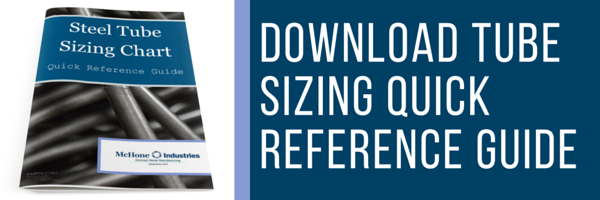
Metal tubing goes through extensive testing to make sure it's up to ASTM standards. A tube's strength goes in two directions: tensile (outwards, pulling) and compression (inwards, pushing).
Each size, shape, and material has two measurements of tensile and compression strength: yield (the amount of force needed to bend the metal) and ultimate strength (the amount of force needed to completely break the metal).
The standard tests manufacturers use to check tube strength use enough force to bend the tubes, but should not break them. The tube is purposefully bent, pressed, or otherwise stressed beyond its yield point, and if it breaks, it fails the test.
There are multiple tests a manufacturer can perform to check tube strength. The tests are designed to check the strength of the tube overall, as well as to check the strength of the weld seam. To pass, the tubes should so no sign of defects, cracking, or splitting along the seam.
Tensile
Tensile tests are conducted to test the ductility and elongation resistance of the tube. The tubes are stretched outwards, and if they fracture or neck, they fail the test. These tests are generally held at room temperature.
Bending
The tube is bent around pulleys to a specified angle. Bends can be smooth or wrinkled, but any cracks will fail the test.
Flattening
The tube is placed with the weld seam facing to the side, and is squished between two metal blocks, completely flattening it along the seam. The reverse flattening test places the seam pointing upwards toward the top block.
Flange
The edge of the tube is flanged, or flattened outward to form a lip.
Flaring
Pressure or physical impact is applied to one end of the tube, while the other end is placed over a cone. The tube is pressed onto the cone until it has expanded to a specific point. Another similar test, called the ring expansion test, performs the same operation. However, ring expansion aims to completely fracture the tube to test its ultimate strength.

Crush
Similar to the flare test, only the tube is placed on a flat surface rather than a cone. The tube is crushed into the surface by pressure or impact.
Hydrostatic
Liquid is forced through the tube to check for leaks or damage. This test is especially important for tubing used in fluid transportation.
Nondestructive
There are also nondestructive tests that can check the strength of tubing. Hydrostatic testing is a type of nondestructive test, as the tube can still be used once the test is complete. Other forms of nondestructive testing include eddy currents, magnetic testing, and other particle-based inspections.
Creep
Creep is not a type of testing required by the ASTM, though it's useful in the long term. To perform this test, tubing is placed under constant stress over a long period of time (sometimes years). The test measures how much deformation will occur in that amount of time under that specific pressure. For long-term structural applications, this data can save a lot of time and money in repairs.
There are other ways to test the strength of tubing, depending on its intended application. The tests listed here are some of the most common.
If you have more questions about ASTM standards or testing, we're happy to help.


